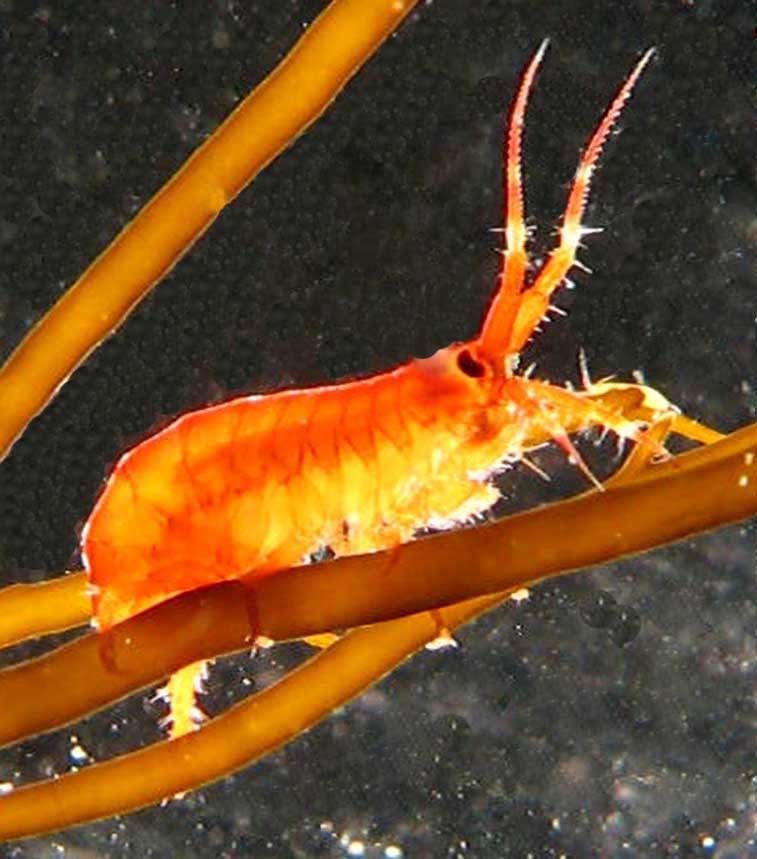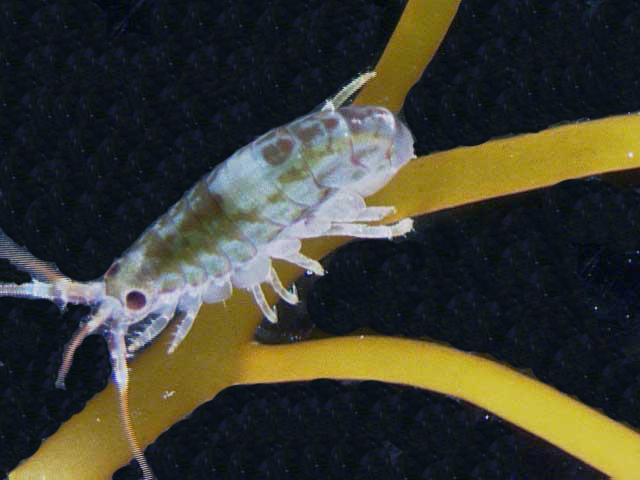
The last time we talked, I briefly mentioned the objective of our experiment for this field season. If you don’t remember, let me refresh your memory.
Our oceans are becoming more acidic, which can be a problem for species that need to calcify parts of their bodies such as amphipods needing calcified exoskeletons (like the Bovallia gigantea pictured above). Previous experiments from our lab have shown that some species of amphipod here on the Western Antarctic Peninsula survive better or worse compared to other local amphipod species. We want to know why this is happening.

To do this, we have a fairly elaborate experimental setup but don’t worry. The picture of the setup above has labels on the components I will be talking about. Our experiment is held within two large round tanks that are located in the aquarium. A total of twenty-four experimental buckets are placed on submerged platforms in both of the aquarium tanks (twelve in each tank). The aquarium tanks are plumbed with ambient flow-through seawater to create a seawater bath to keep all of the experimental buckets at ambient temperature. The tops of the buckets are elevated above the water level of the seawater bath.

Each experimental bucket is filled with four amphipod containers that will hold each of our study species. Our four study species were categorized as “winners” or “losers” based on our results from our 2020 season. These species include our two winners, Djerboa furcipes and Bovallia gigantea (pictured above) and our two losers, Gondogeneia antarctica (pictured below) and Prostebbingia gracilis. Along with the amphipods, each container holds a plastic aquarium plant that has been seeded with diatoms and held in an outdoor tank with unfiltered seawater for weeks to allow the growth of a diatom food source for the amphipods. In addition to the diatom-covered plastic plants, pieces of Palmaria decipiens, a palatable alga, will be placed in the containers as an alternative food source and live amphipods will be placed in one of the containers to feed B. gigantea which is known to prey on smaller amphipods.

Filtered seawater collects in a common header tank that helps maintain constant water pressure. The seawater flows out of the header tank into a water distributor located in the center of each aquarium tank. Each distributor is outfitted with tubes that run into the mixing tanks where the water will eventually flow into the experimental bucket and finally into the water bath.
Okay, that was a lot of information to explain the general layout of the experiment, but how are we doing the actual science? Well, a good chunk of that is occurring in the mixing tank. For this experiment, we need to lower the pH of the seawater going into specific experimental buckets. Are we acting like mad scientists with lines of acid dripping into each of our tanks? While that does sound very cool looking, the answer is no. Our methods are much simpler and align closer with what is happening in our oceans. We just bubble CO2 in the water.
In addition to the water tube, each mixing tank also has a pH probe, a tube with mixed air and compressed CO2, and a tube with air alone. The pH probes are connected to a computer that can individually control the pH of each mixing tank. If the pH is too high, the computer turns on the CO2 line. The CO2 bubbles until the pH reaches its set point, and the computer turns the line off. If the pH gets too low, the air lines are turned on to bring the pH back up.
For this experiment, we have eight buckets per pH treatment: around 8.1 for ambient seawater, 7.7 for near future, and 7.3 for distant future pH predictions. The eight buckets for each pH treatment were randomly assigned within each water bath. Each bucket has a clear Plexiglass cover to reduce gas exchange with the rest of the air in the aquarium because this could impact the pH of the water.
Whew. That was another avalanche of information, but we aren’t done yet! There is one last piece of the experiment we need to discuss. Although the pH probes are very useful, they cannot be solely relied upon to make sure the pH in each bucket is correct. To have a more in-depth understanding of the water chemistry, a quarter of the buckets have seawater samples collected for pH measurements using a spectrophotometer and total alkalinity measurements using titration every day. The information obtained between these two methods is used to determine a more accurate pH measurement that can be used to adjust the programming on the individual buckets if needed.
I know this was a ton of information, but we made it through this post together. Join me next time for more fun during this Antarctic summer!
A haiku for your consideration:
Many gas lines hang
Within our white mixing tanks
Please, bubble for me